Amazing Animals #25 The Jumping Spiders
Going to try something a little different today and cover a terrestrial Arthropod for the first time in this series, Arthropods include a wide range of animals such as Arachnids, Insects, Crustaceans and many more invertebrates.
I figure it might be a good idea to start with an animal that divides public opinion, which of course means I’m going to be writing about a certain genus of Spider, and we may as well start with a group of Spiders that likely terrifies a large portion of the public, Jumping Spiders.
I feel the fear of Spiders is unjustified in most cases but it is understandable, if you’re taught to fear something from a young age that fear will stay with you, and you’ll eventually pass your fear on to your children, thus creating a never ending cycle of largely unwarranted fear, for the most part we have very little to fear of these 8-legged critters who play an important role in determining the overall health of an ecosystem, some of them even yield mildly intriguing and complex lives.
The Jumping Spider Family
The family group Salticadae, alternatively known as the Jumping Spiders make up the largest family group of all Spiders (Araneae), all in all there are seven sub-families comprising of roughly 600 separate genera containing over 5800 species, the vast majority of species fall into the sub-family Salticinae which makes up around 90% of all known Jumping Spider species.
Jumping Spiders are present on all continents apart from Antarctica and can be found as far north as Iceland, they make up roughly 13% of all of the known spider species on earth (44,000+ total species) and have adapted to a wide variety of habitats, climates and altitudes, for such a large number of species their range in size is not overly large, the smallest Jumping Spiders measure just 0.04 inches and the largest reach just 1 inch in length.
Most species can be found in tropical forests which are known to be the most biodiverse biomes on the planet, Jumping Spiders also exist in desert regions such as the species Phidippus californicus to other extremes such as the species Euophrys omnisuperstes which inhabits the slopes of Mount Everest and has been observed at altitudes of 6700 metres above Sea level.
A key trait of the Jumping Spider is that they do not construct webs to entangle prey, they do however construct web structures known as “pup tents” that they use to find refuge from wet weather as well as to moult, store egg cases and to sleep in at night, they are diurnal predators and their eyes are only useful in daylight which means Spiders in equatorial regions will likely spend half of their day within their lairs, all jumping spiders are carnivorous aside from a few exceptions that feed on pollen and nectar.
We are of course not going to write about 5300 species of Spider so we will instead cover what exactly makes a Jumping Spider a Jumping Spider, before covering Genera that I find quite interesting, hopefully by the end of the article you may have a different opinion on these animals and may opt to take the approach of “save not squish” when confronted with one in the future.
Specialised Adaptations
Jumping Spiders are easily recognisable from a few visual features, namely the shape of their Cephalothorax, the length of their front four legs in ratio to their hind legs and lastly their eyes, of which there are always eight.
A Cephalothorax is the term used to describe the feature of a fused head and thorax, this is a feature observable in all Spiders apart from those within the family group Archaeidae (Assassin Spiders), aside from their extra limbs this is a key difference between Arachnids and Insects (Spiders also have an Endoskeleton as well as an Exosekelton for a random fact).
The Cephalothorax of the Jumping Spider is often a rectangular/square shape and is always shorter than the abdomen, it is also commonly adorned with hair-like or scale-like setae that give the Spider a fuzzy and sometimes cuddly appearance… though that last bit might just be my own opinion, be the judge of that for yourself!
All Jumping Spiders have eight legs, as do all Arachnids, the front legs of the Jumping Spider are often longer (there are many exceptions) than their hind legs though not as dramatically as in the Spider family group Thomisidae (Crab Spiders), unlike the Crab Spiders their legs are rarely outstretched and are often tucked close to the body.
Despite being larger than their hind legs, the front legs play a less important role in the Spiders jumping ability and are used predominantly as a grasping aid when grappling with their prey, their shorter hind legs play a more important role in their locomotion.
Unlike certain Insects such as Grasshoppers which rely on well-muscled legs to jump effectively, the Jumping Spider instead relies on a different mechanism, each of the Spiders legs are split in to seven segments which are the coax, trochanter, femur, patella, tibia, metatarsus and the tarsus, so in total there are six joints within each limb.
Spiders have flexor and extensor muscles just as we do which are used to control the movement at the joints, you might think well… why can’t I jump like the Jumping Spider then?
Well, the Spider does differ from us in that it has no extensor muscles at two of their six joints, specifically the femur-patella joint and the tibia metatarsus joints, this inevitably means that the Spiders aren’t able to extend these segments using muscles, but for the Jumping Spider to jump it must fully extend its legs which is a seemingly impossible task without the required muscles.
To traverse this problem the Jumping Spider instead opts to use their head, but not in a mental capacity, they instead rapidly change the blood pressure within the Cephalothorax, they do this by contracting the muscles that connect the upper and lower plates of the Cephalothorax, this reduces the available volume within the Cephalothorax and forces blood in to their legs.
This instantaneous blood flow to their limbs causes the limbs to rapidly extend and “snap” straight, from prone this causes the Jumping Spider to be launched in to the air allowing some species to jump up to 50 times their body length, to see this phenomenon in action, here’s a video with slow-motion footage showing the largest species of Jumping Spider in action, they grow to a size of 1 inch in length.
The last and probably clearest defining feature of the Jumping Spider are their eyes, they have four pairs of eyes known as the Anterior median eyes(AME), Anterior lateral eyes(ALE), posterior lateral eyes(PLE) and posterior median eyes(PME).
The Anterior median eyes supply the Spider with very good vision, better than most Arthropods, these eyes are surprisingly complex for such a small animal, they are build in way that resembles a telescopic tube that comprises a Corneal lens at the front and secondary lens at the back that focuses images on to a quad-layered retina.
These four layers of photoreceptor cells are specialised in detecting two wavelengths of light, the two closest to the surface are sensitive to ultraviolet light, whereas the two deeper layers are sensitive to green light, this means that the Spider can make judgements on depth under the right conditions.
This was demonstrated at a Osaka City University, their experiment involved bathing six fruit flies in different coloured lights and then introducing them to a white container with a Jumping Spider, the Jumping Spider had significantly improved success rates in catching the flies if they were doused in light between the 300 and 530 nm wavelength and progressively had a more difficult time judging distances as the flies progressed to the red wavelength, it has since been discovered that they also possess red filters in front of the green photoreceptor layers, this appears to be better attuned for simply dictating colour as opposed to depth perception.
The Anterior lateral eyes are much smaller in size and are located either side of the Anterior median eyes, aside from the previously described eyes these eyes produce the best visual clarity and are surprisingly functional, a study written in the Journal of Experimental Biology 2010 213: 2372-2378 states:
In this study, we aimed to determine characteristics of stimuli that elicit orienting responses mediated by the AL eyes. After covering all eyes except the AL eyes, we measured orienting responses to dot stimuli that varied in size and contrast, and moved at different speeds. We found that all stimulus parameters had significant effects on orientation propensity. When tethered flies were used as prey, we found that visual information from the AL eyes alone was sufficient to elicit stalking behaviour. These results suggest that, in terms of overall visual processing, the relevance of spatial vision in the AL eyes has been underestimated in the literature.
Due to the low field of view of the Anterior median eyes (2-5°) these lateral forward-facing eyes may help the Jumping Spider assess a prey target or potential mate faster than if they were to rely on just their two largest eyes.
Finally the two pairs of Posterior Eyes are thought to aid in motion detection, they do not possess the necessary components to format images and are thought to be more sensitive to blue and UV-light, in some species of Jumping Spiders these eyes are thought to be vestigial and offer limited, if any benefit to the Spider, those that have maintained use of their Posterior eyes are afforded a near 360° view of the world around them.
Finding a Mate
You might imagine that finding a mate as an Arthropod is simply a matter of finding the opposite sex and doing what comes naturally to them, this is the most common occurrence in the world of Arthropods, not so for the Jumping Spiders!
These incredible and sometimes beautifully coloured little critters conduct complex displays of courtship, a romantic primordial language of seduction, my favourite example of this can be observed in the mating rituals of the Peacock Spider (Maratus).
The Peacock Spider grows to lengths no larger than 0.2 inches and they have a high degree of sexual dimorphism, similar to the non-related Birds they share their name with, the males are adorned with brightly coloured features and the females are normally a uniform colour that generally appears bland in comparison.
Most male Peacock Spiders are adorned with brightly coloured and iridescent patters on the upper surface of their abdomen, they also possess lateral flaps which they can extend during the courtship display.
The courtship display itself involves a series of synchronised leg movements (the third pair in most species) which the male will raise gradually higher above his cephalothorax, in conjunction with the leg movements the male will also gyrate his pedipalps (the two appendages between the front pair of legs).
The showstopper to his display involves the use of his brightly coloured abdomen, the abdomen is connected to the cephalothorax by a very flexible stem that allows the male to raise his abdomen up to a 90° angle with his cephalothorax, he can also gyrate and wiggle his abdomen to produce increasingly complex dances as he progresses through the courtship display, the end result is a stunning display of leg movement and abdomen control which can be best observed in a video.
As you can see a well-choreographed male will gain breeding rights to a female, sadly as is the case for many Spider species the females are often larger and will opt to cannibalise the male once copulation has ended, this serves the main purpose of supplying her with the energy she will need to ensure her eggs hatch safely.
On average Peacock Spiders will lay just 5-6 eggs per clutch within an egg sac, this is an abnormally low number of eggs for an Arthropod, she will then guard the clutch for up to four weeks, the eggs hatch after two weeks but the young Spiders are blind and unable to feed for the first two weeks as such they require further care, during this time she will not feed or drink and this often results in her demise shortly after the juveniles have reached a size larger enough to venture out of the egg sac.
Thrill of the Hunt
As previously mentioned the Jumping Spiders are diurnal hunters that do not predominantly rely on web-building to catch their prey, they are instead active hunters and are able to use their well-developed eyes to locate and ambush their prey, which is often much larger than themselves, a genus known for their hunting prowess are the Portia Jumping Spiders.
Portia are interesting in several ways because they aren’t purely instinctive predators which is a common trait of Arthropods, instead they can imply logic through visual observations, are able to learn from their mistakes and are capable of plotting methods of attack, they will however still show instinctive hunting behaviours for common prey, as well as prey that pose very little threat to their safety such as flies.
The perceived intelligence of these amazing little Spiders is quite astonishing when all things are considered, their Brain is roughly the size of a pin-head and contains roughly 600,000 Neurons, by comparison our own brain contains around 100 billion neurons and even then, some people can struggle with basic logical reasoning.
Portia can implement trial and error practises in to their hunting techniques, if the attempt was unsuccessful they won’t replicate it again, if it was successful they will likely use the technique again, this behaviour has been observed in laboratory environments when Portia are introduced to unfamiliar prey or situations that otherwise pose complications to them reaching their prey.
They are unique amongst Jumping Spiders in that they can conduct lengthy detours to reach a prey target, these detours are most often carried out when Portia is attempting to ambush dangerous prey such as web-building spiders that may be up to three times larger than themselves.
The detours can appear quite complex and Portia may even break line of sight with its prey when manoeuvring to a more favourable position, as a further impressive feat they may also bypass or completely ignore incorrect routes in favour of their planned detour, the main objective for Portia is to get behind her prey as an attack from the rear poses little threat to themselves.
Whilst most Jumping Spiders pounce on their prey Portia have a couple of other tricks up their sleeves, firstly they regularly employ acts of mimicry to attract prey, their favoured prey consists of web-weaving Spiders, to attract the Spiders Portia will pluck aggressively at the edge of the web in an attempt to mimic a struggling prey animal caught in the web or a courting male, they are persistent animals and may continue this behaviour for a number of days until the prey finally gives in to intrigue.
Should Portia feel that there is no method of ambush or luring available they may employ a different approach entirely, many web-builders can construct webs that span multiple feet in diameter, attracting them via mimicry would likely prove futile and a long range jump would be a very risky move, so instead they have been observed to attack their prey from above, by taking a detour to a higher position they then proceed to abseil from a silk strand down to their target which in the case of web-building Spiders, have very poor eyesight, once in position they can pose from close range on to the back of the Spider, thus nullifying its previously safe location.
All in all the hunting techniques of Portia are advanced for an animal of their size and require a large amount of effort to put in to practise, in many cases Portia have been observed to watch and plan their attack for multiple hours, before embarking on an hour long detour to reach their prey, as such they are considered “slow-thinkers”, I personally find it amazing that they are capable of thinking and reasoning at all.
Content Sources
More Amazing Animals
If you Enjoyed this article feel free to check out some of my previous editions of Amazing animals.
- The Ocean Sunfish
- The Leatherback Sea Turtle
- The Fruit Bats
- The African Elephant
- The African Lion
- The Arctic Fox
- The Peregrine Falcon
- The Komodo Dragon

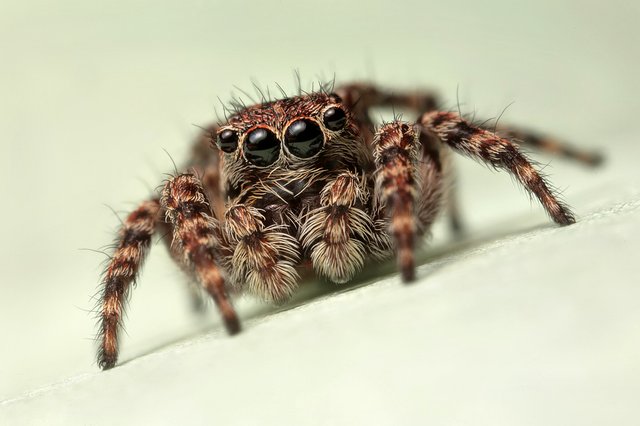
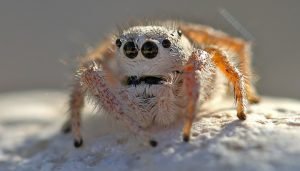
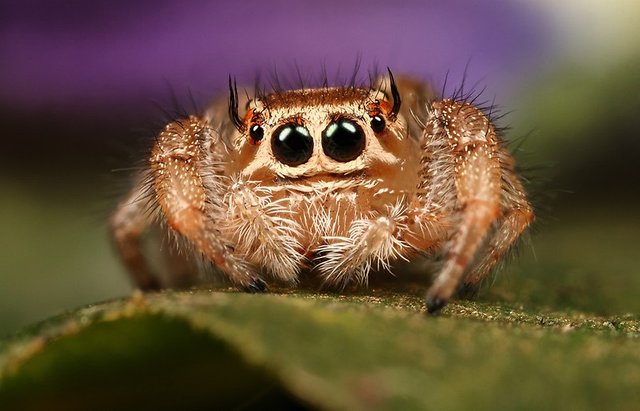
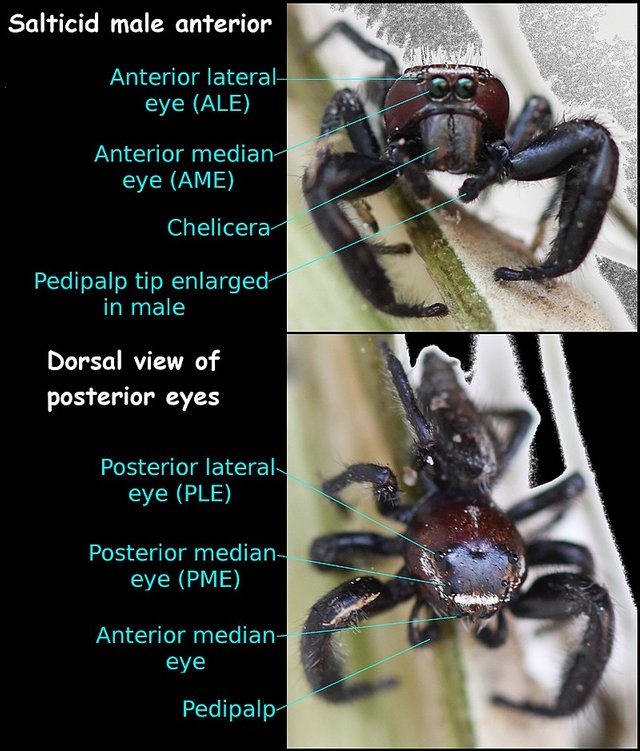
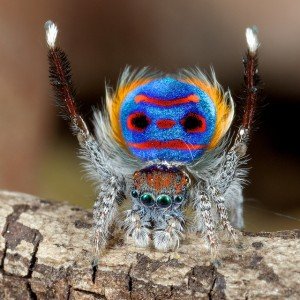
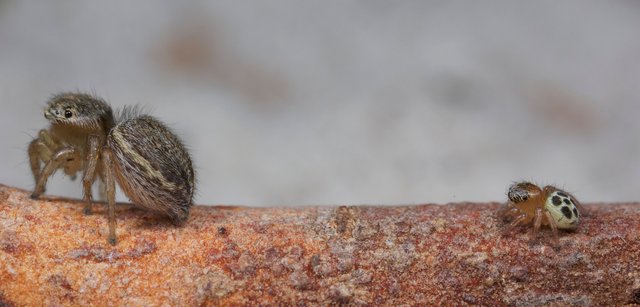

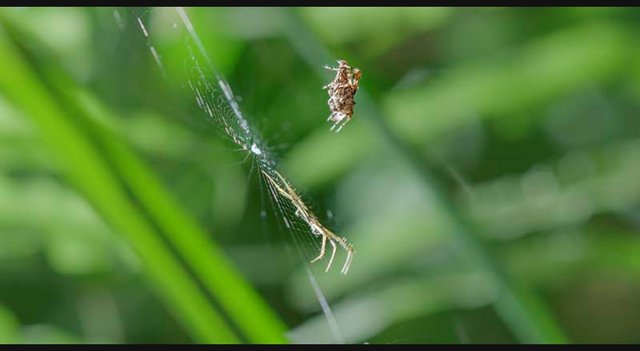
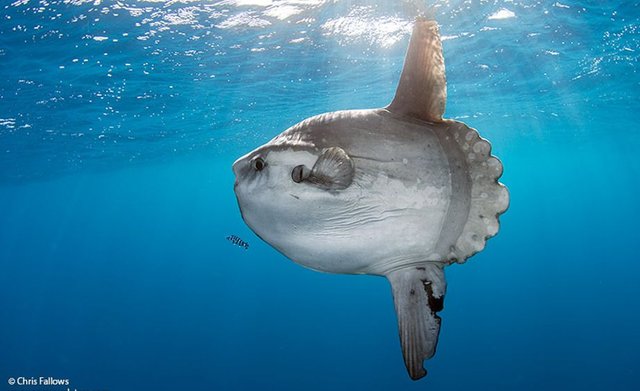
Being A SteemStem Member
yikes!
Hi @amavi!
I'm happy to include this post in the CTR Crossword Puzzle No.-16. All participants for this puzzle will land on this post to find their answers to it.
Thank you for creating awesome content which is just perfect for our participants!
P.S.:
Hey, all readers of this post! If you want to participate in this contest, you’ve got a slight edge over others as you have already read this post. All of you are welcome to participate and have fun. Check the posts containing hints for the Crossword Puzzle here.
This is fantastic! What an amazing idea you have created!
Thanks for appreciating it!
First article I read this morning. Absolutely wonderful. Such detail. Great videos. Clear language. You define terms I didn't know, such as Cephalothorax. I think the post sets a model for other posts. I was left with one question. Perhaps I missed the answer. What is the natural lifespan of a jumping spider? I guess it varies by genus. Can't imagine it's very long--propagation would seem to insure the demise of both male and female (though males have a chance of surviving and getting eaten by their next mate :) ). I resteemed and am going to link on Twitter.
Glad you enjoyed the post!
I thought I mentioned it in the article but I didn't , the average lifespan of Jumping Spiders does vary at the species level and is mainly dictated by climate, generally speaking most species have an average lifespan of around 10 months, some species can survive for as long as 18 months.
Thank you. Am sharing a video of Jumping spiders with a very young child I know, who loves science. Nice thing about learning--it's contagious.
I love Spiders. This ones are amazing
some species may live longer, especially in cold climates where they have to be dormant for many months each year why sone dont live for more than a year
Resteemed to over 13800 followers and 100% upvoted. Thank you for using my service!
Send 0.200 Steem or 0.200 Steem Dollars and the URL in the memo to use the bot.
Read here how the bot from Berlin works.
We are happy to be part of the APPICS bounty program.
APPICS is a new social community based on Steem.
The presale was sold in 26 minutes. The ICO will start soon.
Read here more: https://steemit.com/steemit/@resteem.bot/what-is-appics
@resteem.bot
no im notttabot
Have you seen the tiny spider Lucas cartoon?
interesting this jumping spider, a spider that plays an important role in the planet, since God created everything with a purpose.